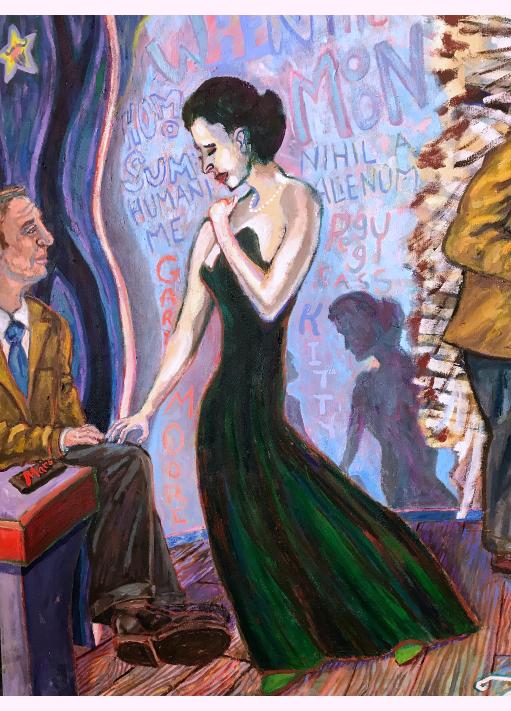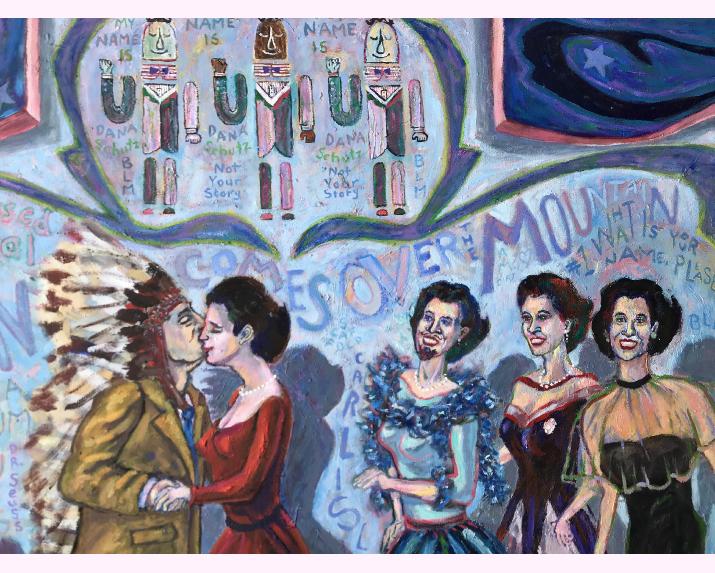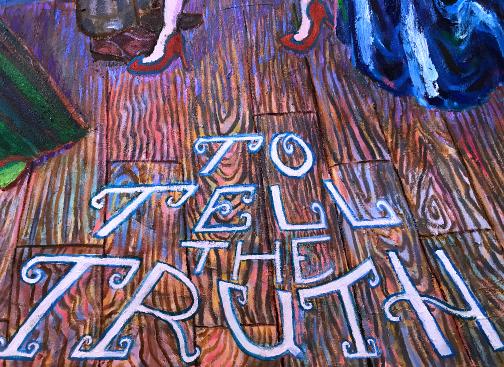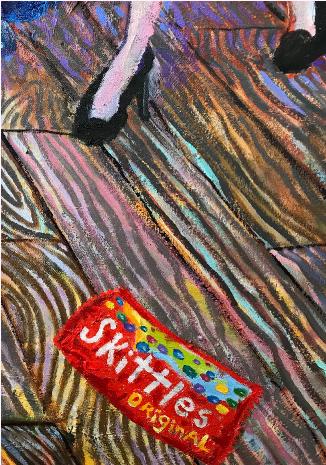Click image to enlarge | ||
The inspiration started with a touch, Kitty Carlisle touched my knee as she navigated past me at a 1983 reception in Aspen honoring her and the exciting release of the restored 1954 A Star Is Born with long lost footage. Later at a second venue, I was a plant, tasked to ask her about Garland’s wildly fluctuating weight in the picture. Kitty responded with an anecdote about finding Garland hiding in the wings between filming takes backstage at the Pantages Theater. She was enjoying a Mars bar, and Kitty admonished her explaining, “My mother always told me NEVER to get fat eating cheap chocolate.” To which Garland replied, “It’s the only kind I like!” Both women were “beards.” married to gay men. So in the painting one of the 6 Carlisles sports a goatee, as do the 2 rainbow stars on the proscenium representing Garland and a few of her lavender spouses. Garland’s Mars bar is on To Tell the Truth host Garry Moore’s desk, and he is receiving the touch Kitty gave me. The set is a collage of elements from the game show’s many looks. The stars not only refer to Garland, but echo the motif of Aspen’s then recently revamped Wheeler Opera House, my biggest and most formative cultural touchstone growing up.
In the painting,a dazzling Carlisle appears 6 times, recreating her famous sweeping entrances on the set. Host Garry Moore appears twice. His final quip upon greeting Carlisle on his last appearance before an early retirement due to a fatal cancer, are written above him, “Kitty, underdressed as usual...” The repetition of theKitty's gives the feeling of something happening again and again. Kitty keeps coming and coming and coming just like the constant cycle of gun violence and mass killings in this country that took the life of Harvey Milk referenced by his killer's twinkie in the lower left or the frequent heavy handed violence against people of color such as Trayvon Martin represented by the Skittles. I read that it is not my place to tell some of those stories with my art, so a simple BLM appears in the background text in three places and I speak up indrectly through the metaphor and symbols of the painting. Repetition juxaposed with symbols of a few terrible homocides represents routine mass gun killings and racsim coupled with violence that plague America and just keep coming.
Besides violence, the painting explores another aspect realated to racism that is cultrual appropriation. The complexity of navigating evolving mainstream values and sensiblities is the source of contentious disagreements and misundersandings. “Not your story,” has become the toxic charge levied repeatedly against well intentioned artists whose work calls attention social injustices committed against people from different and less privileged walks of life. The premiss of the game show To Tell The Truth is the perfect metaphorical backdrop to raise questions about blanket accusations of appropriation and rascism. On the show for each game, 2 of the 3 contestants are imposters who deliberately tell a story that is not their own to stump the panel. But in real life, humanity’s stories belong to us all. None of us are imposters. You don’t have to be Jewish to relate to the holocaust, or black to sympathize with the Black Lives Matter movement, or sexually assaulted to support MeToo. Artists speak up about what issues compel them, no matter what their gender, race, sexuality, culture or societal privilege is. Anne Frank’s words were about universal truths and her legacy is for all of us. Willam Shakespeare wrote about kings, but was revealing aspects of our collective nature. Painted background text includes Terence’s quote “Homo sum: humani nihil a me alienum.” (I am a man, nothing human is alien to me.) We all share humanity's greatest achievements and worse failings. We are all human and all that is human belongs to us.
This painting is my plea for understanding and thoughtful consideration of historical context when looking back at an artist’s body of work, and everyone's right to claim and empathize with our own total collective human experience far beyond the narrow limits of one's own identity groups of gender, race, religion or generation. Artists, writers and performers who have found themselves canceled due to the content of their artwork are referenced in the text: Dr. Seuss, Dana Schutz, Kate Smith, Jeanine Cummins, Laura Moriarty and Sam Durant.
Performers both appropriated music and cultures from around the world as musical tributes not as racism. They wouldn’t do it now and it is a jolt to our sensibilities. But then it was no different than performing with a different accent like Streep in the Sophie’s Choice. It was acceptable to the mainstream and commonplace. Exotic costumes, accents, mannerisms, etc were then all acceptable tricks of the trade, not meant to be disrespectful. It is not fair to judge an artist for different values 90 years ahead of their time and for circumstances out of their control. Nowadays, actors are publicly vilified for daring to play trans-characters. Yet just a few years ago, Jared Leto was given the Academy Award for doing so, and Jeffery Tambour the Emmy. Felicity Huffman also received acclaim playing trans. It is what actors do by definition, play characters who are different than themselves! I am all for casting trans actors when possible. It is often not financially viable to launch a several million dollar production without a star attached. Unknowns and lessor talents do not get the leads. Including trans actors where possible is fantastic. But it should not preclude capable others from also playing those some of those roles. Back to Terrence and this painting: I am a man, nothing human is alien to me.
What if I paint a person of color? Am I committing cultural appropriation? If I don’t include people of color in my paintings, can I be called a racist for not including them? It’s becoming a scary, lose/lose situation for some figurative artists like myself, for writers, actors, musicians, etc. My painting career is not over 30 years old. Already there are some choices I made early on that I would not make today. Never were they made with ill intent or disrespect. In fact, quite the opposite. Time change fast. And I can still repaint...
I sympathize with most artists accused of cultural appropriation. If Dana Schutz is moved by Emmett Till’s murder, if Jeanine Cummins is moved by Mexican migrants’ struggles, Laura Moriarty wants to create a Muslim character, if Sam Durant is moved by injustice to Native Americans, if I moved by Trayvon Martin and want to include Skittles in my painting to remind people of his story, we are human, these things happen in our society, we should be free to speak about them. Calling attention to injustice is what artists do. Yet our society’s younger, in many ways more enlightened members are rallying against artistic freedom, our shared human experience and capacity for empathy, insisting that only certain people can tell certain stories. I don’t have the answer for what is wrong or right, but I will take a stand and support those artists trying to call attention to injustice and use their voice for good no matter who they are. The stories of humanity belong to us all.
And in the end I decline to judge all the Mickey Rooneys, Lucille Balls, Dr Seusses, young would be politicians (not really in minstrel blackface, but dressed up in costumes of other races and dark makeup that is today clearly understood hurtful stereotyping in all contemporary context), and others who made some very poor choices. Who among us hasn’t made a bad joke or said something poor taste that they later regretted? Artists take risks, and some of them don’t work out. We learn and grow from our failures and the failures of others. Making a racist image doesn’t prove its creator was a racist. That may not have been the intent, just a poor artistic choice or ignorance perhaps? My beginning art students often create images that read offensive or ignorant that they didn’t intend or think through carefully.
Another fantastic quality of being human is the capacity to forgive, and given context, I choose to forgive mistakes of ignorance and poor taste. I’ll give the benefit of doubt for outdated, public, ill-advised artistic choices, rather than to label someone a racist when obvert racism wasn’t their intent. Racism does not have to be obvert to be racism, it can manifest itself in small subtle ways. I know this. I know many feel differently than I do. Arguments to the contrary are reasonable. But rather than judge based solely on imagery, I give the benefit of the doubt where possible and try to forgive. We are all human. | ||
 | ||
 | ||
 | ||
Betweem the wood grain it is easy to see the colors of an earlier environmental painting I did in the late 80s when few others were really doing that kind of content in art. | ||
 | ||
Some great fun and visual inspiration for this painting: Kitty Underdressed for the Occasion as Usual https://www.youtube.com/watch?v=lupfll3G9vQ
| ||